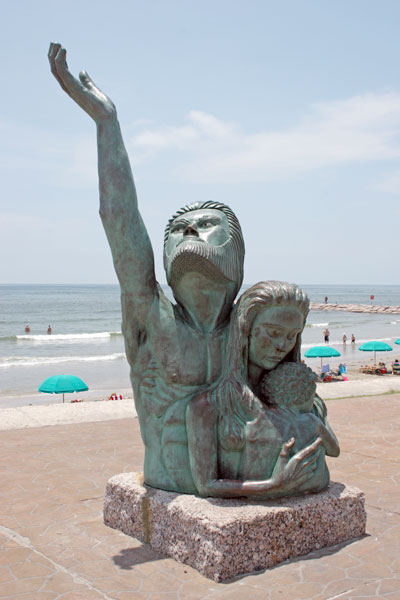|
|
Home | High-Res License | Website License | Free Pictures | About |
Architecture | Page 29 | « Prev | Next » |
|||||
1900 Storm MemorialPurchase / Licensing / Usage Rights (Image #C09748)
|
|||||
 |
|||||
 More Photos More Photos |
Architecture | Page 29 | « Prev | Next » Texas | Page 3 | « Prev | Next » |
||||
|
Purchase / Licensing / Usage Rights (Image #C09748)
|
|||||
In memory of the victims lost at sea during the Galveston hurricane of September 8, 1900, fourth-generation Galvestonian artist David Moore created this memorial, "Place of Remembrance", to commemorate the 100-year anniversary of the storm. The monument was dedicated in a ceremony held on September 9, 2000; the work represents the suffering of the victims and the strength of the survivors who stayed to rebuild the city. The 10-foot-tall bronze sculpture portrays a family - a father, mother and child - clinging together. One of the man's arms is reaching for the sky, and the other is around his wife. She is cradling their baby in her arms. During the ceremony, cards with names of the victims were placed in a vault beneath the sculpture. Also, the U.S. Coast Guard cutter Harry Claiborne was positioned offshore; the ship's crew and their guests scattered rose petals in the water to commemorate those who died in the storm. The crowd at the ceremony sang along to the French song Queen of the Waves. The Sisters of Charity of the Incarnate Word sang the hymn in 1900 at St. Mary's Orphan Asylum in Galveston to calm the 93 children in their care during the storm. The storm claimed 90 of the children and 10 nuns. The hymn was dedicated to them and the others lost in the storm. An identification plaque at the base of the sculpture reads by David W. Moore, Sculptor Cast by United Metalsmiths Houston Sponsored by Galveston Commission for the Arts A plaque with a description of the storm is also nearby, with the following inscription: The 1900 Storm Commemorative Sculpture, dedicated on September 9, 2000 represents the suffering of those who perished and the tenacity of those who survived this nation's deadliest natural disaster. On September 8, 1900 a powerful hurricane struck Galveston Island, killing more than 6,000 people and leaving the island in ruins. The next day the survivors began the cleanup, and the city began making plans to rebuild the island with a seawall to protect it against future storms. Over the next decade, the wall was completed and the land behind it raised. These measures served Galveston well. In 1915, when another intense hurricane struck the island, less than a dozen people living behind the seawall lost their lives. |
|||||
|
Architecture / Buildings | Hawaii | Sunrises / Sunsets | Wildlife / Animals | Babies
Hot Air Balloons | Colorado | Willie Nelson | NBA | Misc | Aircraft | Texas Home | Search | High-Res License | Website License | Free Pictures | About | Privacy Statement Copyright © 2006-2017, Allen Matheson
|
|||||